A Year in Illustration
Creating visuals for abstract ideas with the public domain, fair use, Creative Commons and zero artistic talent.
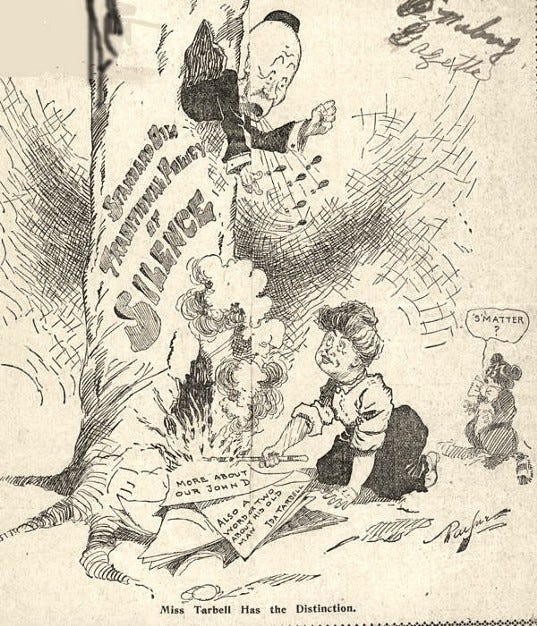
Back when we were inventing blogging, most posts did not have illustration, which was good for me, since I can’t draw so much as a stick figure, and there was precious little in the way of public domain or otherwise freely reusable stock art.
The rise of social media — with its automatic thumbnails pulled down from a “hero image” from the post — meant that bloggers like me had to start finding illustrations for my work. This was made doubly hard by the fact that I mostly write about abstract ideas that don’t suggest obvious illustrations. Add to that the rise of copyright trolls who see bloggers as piggy banks to be inverted and shaken for “infringement settlements” and illustration becomes a fraught and difficult business.
And yet, I soldier on, mostly because years of trying (and largely failing) to come up with illustrations for my posts made me stubbornly habituated to the practice, and because I am unwilling to surrender.
This year, I feel like I finally hit my stride. Thanks to some recurring motifs — close-cropped and sitting in a folder on my hard-drive — and a mixture of Creative Commons-based Google Image Search, Openverse, and Library of Congress searches, I’ve found a way to re-create the editorial illustrations of the bygone era (Victorian and beyond), where subtlety is nowhere to be found.
Below, I’ve collected my favorite collages of 2022, along with some production notes for other would-be latter-day villainous woodcut producers.

This one, for “The Mafia hires good accountants” uses this club-wielding giant, clipped (I think?) from an early 20th century socialist magazine. The eyeshade, desk and lamp are public domain clipart.
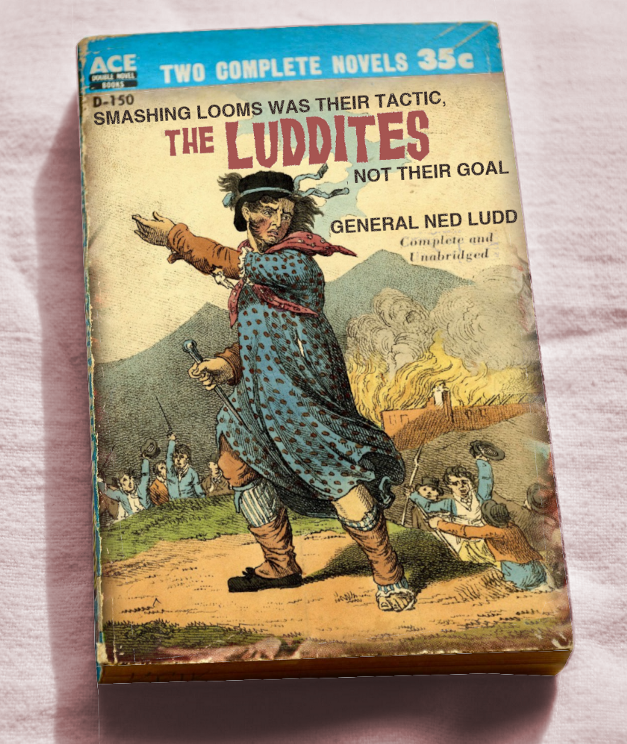
To illustrate “Science fiction is a Luddite literature,” I took a picture of an old Ace Double I pulled off my bookshelf, downloaded some freely usable pulp fonts, and collaged them with this early 19th century etching of General Ludd.

To illustrate “Cops’ imaginary fears send addicts to real jail,” I mixed together a Thin Blue Line flag template with Zack Middleton’s CC BY-SA 2.0 pizza photo, to make the point that pizza deliverators have statistically riskier jobs than American cops. It’s my take on the Tumblr “Thin Crust Line” meme.

I remixed the California state flag for “California’s chance for universal health care,” about the Medicare for All bill that was heading for Newsom’s desk (he vetoed it, womp womp) (seriously, fuck that guy). The California state flag is super-remixable! Devin Cook’s vectorized version on Wikimedia Commons is an old friend. The scrub cap and mask came from public domain clip-art.
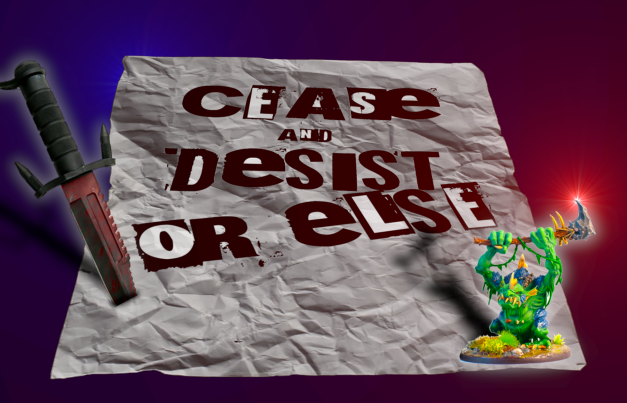
To illustrate “An Open Letter to Pixsy CEO Kain Jones, Who Keeps Sending Me Legal Threats,” I mixed together a public domain image of a knife, some public domain blood-spatter, a public domain crumpled sheet of paper, a freely usable ransom-note font and Tobias Bomm’s CC BY-2.0 beautifully painted river troll D&D mini. This marked the beginning of my love affair with The Gimp’s Supernova filter.

One of the cool things about being a Bitcoin skeptic is the vast efflorescence of tacky, CC0 cryptocurrency artwork, like this coin in the illustration for “A Comprehensive Synthesis of the Technological, Ecological and Political Critique of Blockchainism.” The trashcan guy icon is public domain, as is the garbage heap. Weirdly, the U.S. Fish and Wildlife Service claimed a copyright over the forest-fire image, even if they did go on to release it CC BY 2.0 (works of federal authorship are public domain).
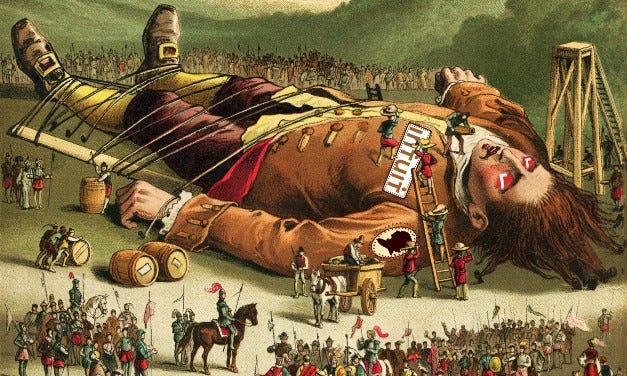
I am indecently happy with this illustration for “Mass arbitration attack could bring Intuit to its knees.” I started off looking for public domain images of Lilliputians binding up Gulliver but all the versions I found were covered in stupid Alamy watermarks, despite being long out of copyright. I used the Alamy sell-pages for these illos to figure out what book the image came out of, then located a high-rez PDF scan of the antique volume on the Internet Archive, paged through it until I found the image, then ganked it. The Federalist Society logo and Intuit logos are all firmly fair use — I’m criticizing both with this illustration.
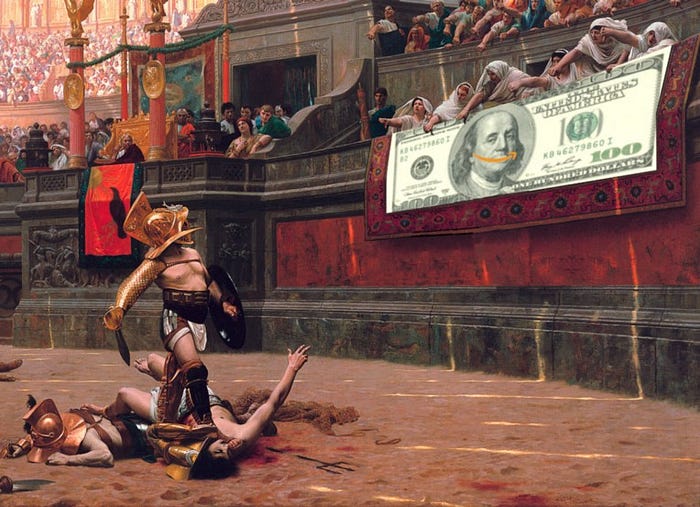
For “Amazon’s $31 Billion ‘Ad Business’ Isn’t,” I started with Jean-Leon Gerome’s 1872 painting Pollice Verso, adding the Amazon logo (fair use) and the US $100 bill (public domain, as a work of federal authorship). Some very fiddly lasso tool work around the onlookers’ hands for this one.

“How ‘hollowed’ hotels are destroying worker rights” is about REITs infecting hotels like intestinal parasites. I combined a public domain hotel postcard, a 19th century editorial cartoon of Boss Tweed (with a moneybag for a head!), a French Revolutionary era drawing of a guillotine, some judicious Gimp supernova effects, and SuSanA Secretariat’s CC BY 2.0 image of super-grody gut worms.

I got to revisit tacky Bitcoin art for “Defi and Shadow Banking 2.0,” mixing Derrich’s spooky CC BY-SA 3.0 stormcloud image (inverted the colors and flipped it vertically) with Ed Uthman’s CC BY-SA 2.0 First Bank of the US image. Really leaning into the supernova effect here.
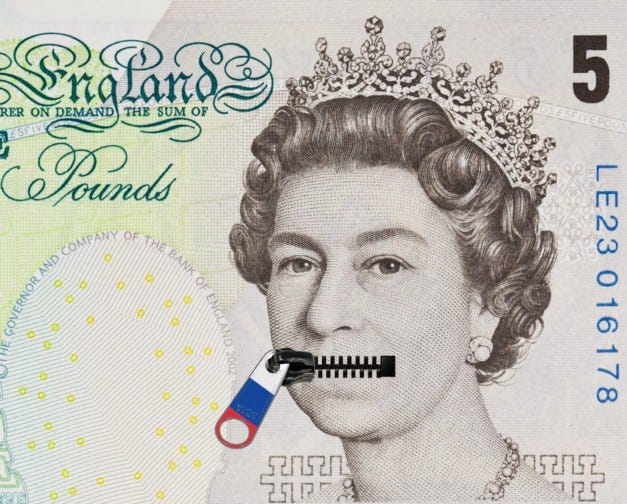
I spent a long time carefully erasing the Queen’s mouth from this 5 pound note (Crown copyright, but I think that’s bullshit and the exchequer is welcome to serve me with papers).
The zipper came off an old Sears and Roebuck catalog (I cranked up the contrast and then cleaned up the lines) and then I found a big ole zipper-pull and gave it Russian flag tricolors.

For “What is ‘Peak Indifference?’” I superimposed a public domain “shrugging guy” silhouette over Cameron Strandberg’s forest fire pic (CC BY 2.0). Getting the silhouette right took a lot of playing with layers; I ended up making a slightly larger selection on an intermediate layer and giving it a contrasting color for a limning effect.

I’m gonna say that this illustration of a ‘big brain’ Talosian alien from ‘The Cage,’ the 1965 pilot for Star Trek is either fair use or di minimis or both. It paired well with Anthony Quintano’s CC BY 2.0 pic of a 2019 Mark Zuckerberg keynote. I didn’t quite manage to match the skintones, but I think that makes it funnier. This one was for “How and why to break up Big Tech.”

One morning, I spent a good hour making a template of the Penguin edition of Ayn Rand’s “Atlas Shrugged,” which I use all the time, when I want to criticize her ideology (which makes it fair use). This one was for “The SEC Must Not Legitimize Fake ‘Carbon Offsets’” and I combined it with this found remix of Rich Uncle Pennybags from Monopoly (note the supernovas!). I really wish I knew who made this! NASA supplied the picture of the Earth from space (federal agency, thus public domain). The flames come from Cristian Ibarra Santillan (CC BY 2.0).

For “The Byzantine Premium,” I started with Famartin’s CC BY 4.0 pumpkin pie image, adding in some CC0 tacky Bitcoin art, and various icons. This one nicely decomposed into illos I used for subsections of the article:





Animations are tricky! They’re giant files, and fiddly to make. This one, for “Late Stage Capitalism Is Weird Capitalism,” was built out of a classic Gilded Age editorial illustration, which I ran through EZGif for many, many passes.
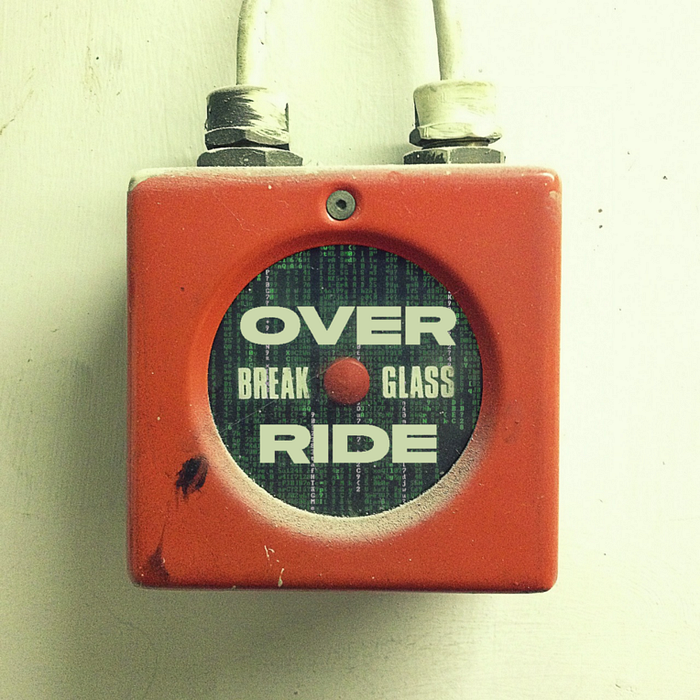
The Matrix “code waterfall” effect is a great way to evoke, “This is happening somewhere in the virtual realm.” Here I combined it with a public domain image of a fire alarm for “When Automation Becomes Enforcement.”
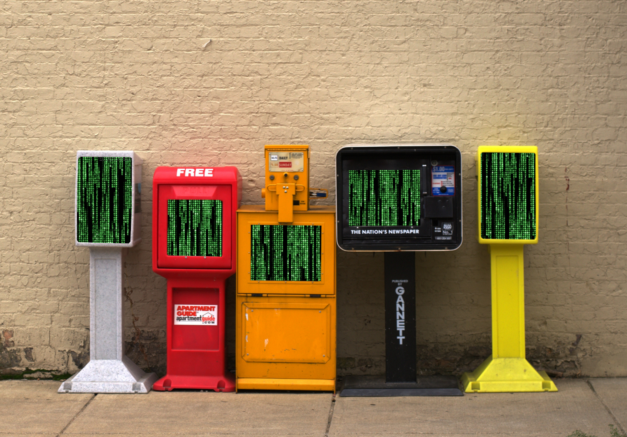
The Matrix code waterfall is back, merged with a public domain photo of some newspaper boxes, in “Big Tech Isn’t Stealing News Publishers’ Content.”
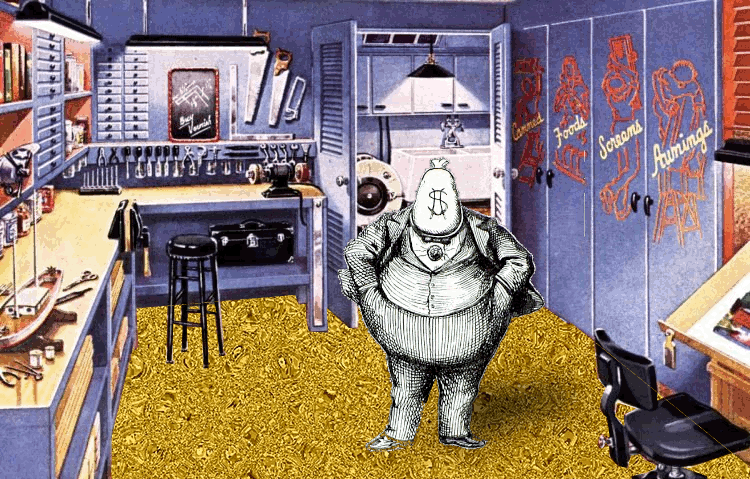
Boss Tweed is back, along with a hand-tinted public domain image of a basement rec-room from an 1930s scientific experimentation magazine, for “America’s 400 Top Earners Pay Less Tax Than You.” These glitter effects are surprisingly easy in the Gimp.
For “Revenge of the Chickenized Reverse-Centaurs,” I combined a public domain image of a warehouse worker with a public domain image of a horse, and then replaced its eye with Cryteria’s CC BY 3.0 HAL 9000 image, which I use all the time, as a way to denote, “Your computer is doing something bad to you.”

To illustrate “A New York law to end to Wall Street’s pension ripoff,” I combined my cutout of Sam Valadi’s CC BY 2.0 Charging Bull image, this photo I took in China of a street panhandler, another found Uncle Pennybags image (another one I’d love to be able to attribute!), this Wall Street sign from Jsquish (CC BY 3.0), and Ken Lund’s CC BY-SA 2.0 picture of Wall Street.
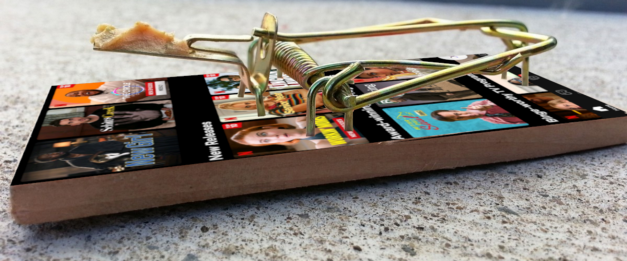
For “The Fatfinger Economy,” I mixed together my painstaking cutout of this mousetrap (public domain) and a homescreen for a streaming video app.

Apple’s iconic ad campaigns are the gift that keep on giving —that Think Different wordmark (fair use) turns any image into a criticism of Apple. For “Apple’s Cement Overshoes,” I superimposed Conal’s run-over-by-a-bus Iphone (CC BY 2.0) on a public domain image of oceanbottom plastic trash.

For “Against Cozy Catastrophies,” I used Gerald England’s CC BY-SA 2.0 image of the Glenarm Castle Walled Garden, Djuradj Vujcic’s No Trespassing sign (CC BY 2.0, a perennial favorite!), a public domain apocalyptic cityscape, and some public domain clip art of hands.
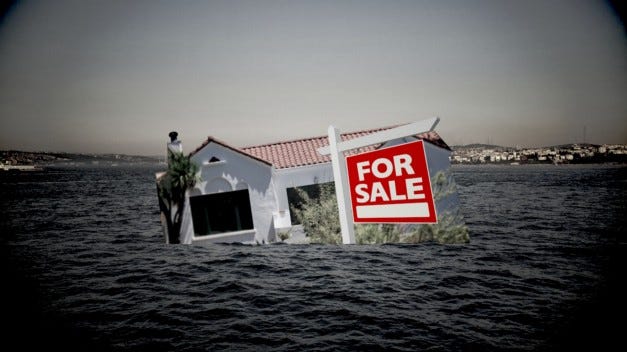
To show a house underwater for “House sales are cratering but inventory is soaring,” I used an image from Tony Mariotti, a realtor who asks that his CC BY 2.0 images be linked to his website. The For Sale sign is public domain clipart, and the flooded cityscape came from FEMA (fed agency, public domain!).

Cryteria’s HAL9000 image (CC BY 3.0) is back, menacing visitors to Paul Sableman’s CC BY 2.0 Planned Parenthood clinic in “Abortion surveillance only incidentally involves period-trackers.” Cutting out the skyline was a pain in the ass, and the supernova filter covered some of my mistakes.

“Your computer is tormented by a wicked god” plays all the hits: a Matrix code waterfall, Cryteria’s HAL 9000, and a public domain oil painting of a bearded God cradling the Earth.

I did a better job blending the skin tones for Dan Taylor’s CC BY 2.0 image of Peter Thiel with this fair use/di minimis image of Mike Meyers as Dr Evil than I did with Zuck and that Star Trek alien (for “Peter Thiel’s evil, but he’s not an ‘evil genius.’”)
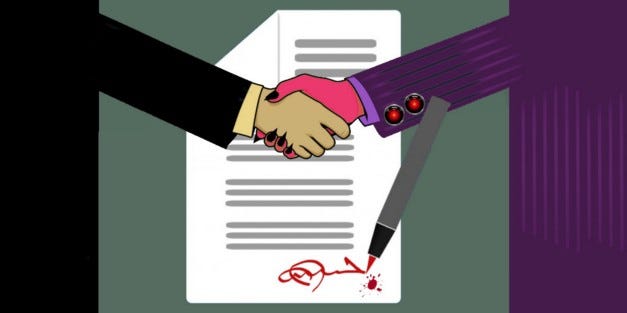
I love how this came out for “A modest proposal to fix contracts.” I used Hugh D’Andrade’s EFF TPP banner image, colored one of the hands and gave it pointy black fingernails, added some Cryteria HAL9000 cufflinks, and then stuck in a free stock image of a signed contract, turning the ink bloodred.
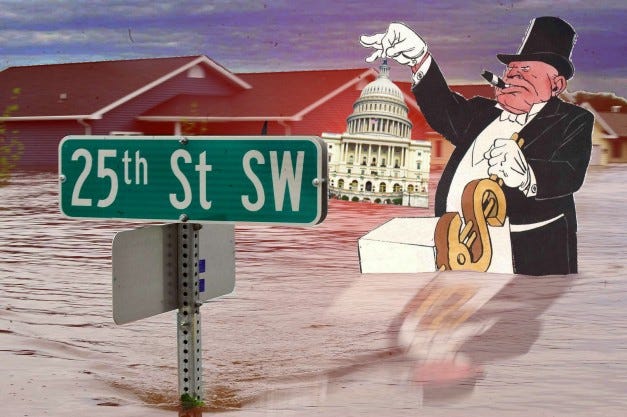
The main figure in “Every billionaire is a factory for producing policy failures” is my careful cutout of a Soviet editorial cartoon called “Capital Controls the Government.” MrT HK’s picture of Congress (CC BY 2.0) looks good between his fingers. The flooded city comes from FEMA (yay, federal agencies!). I am indecently proud of the ripple reflection I managed.
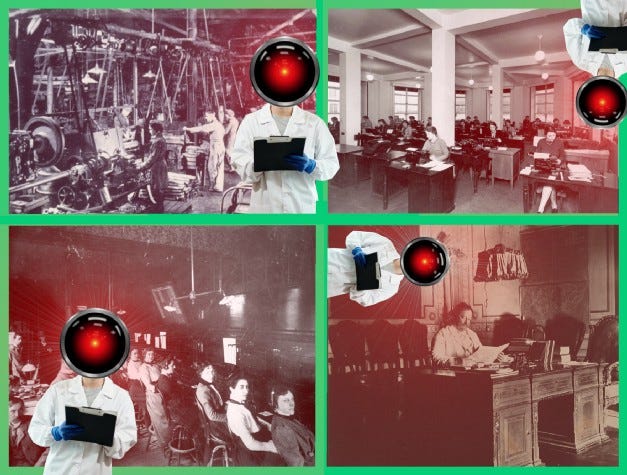
Take one public domain clip art image of a dude with a clipboard, mix in Cryteria’s HAL 9000 eye, and four illustrations of early industrial workplaces, and you’ve got the perfect illustration for “Workplace surveillance is coming for you.”
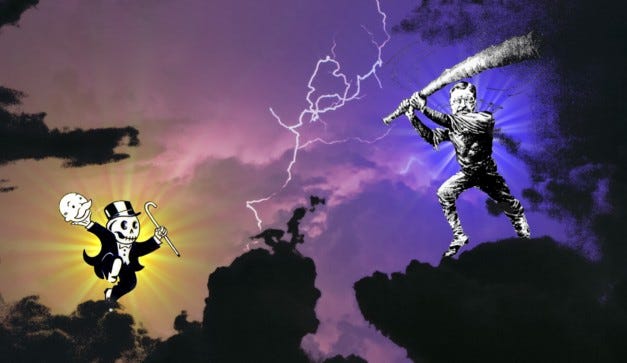
“Maintaining monopolies with the cloud” is another one of those super-abstract pieces; I illustrated it with one of those found Rich Uncle Pennybags dudes and my close cutout of a turn-of-the-century editorial cartoon of Teddy Roosevelt as a “big stick” swinging trustbuster. The clouds are public domain, and I think the supernovas came out great.
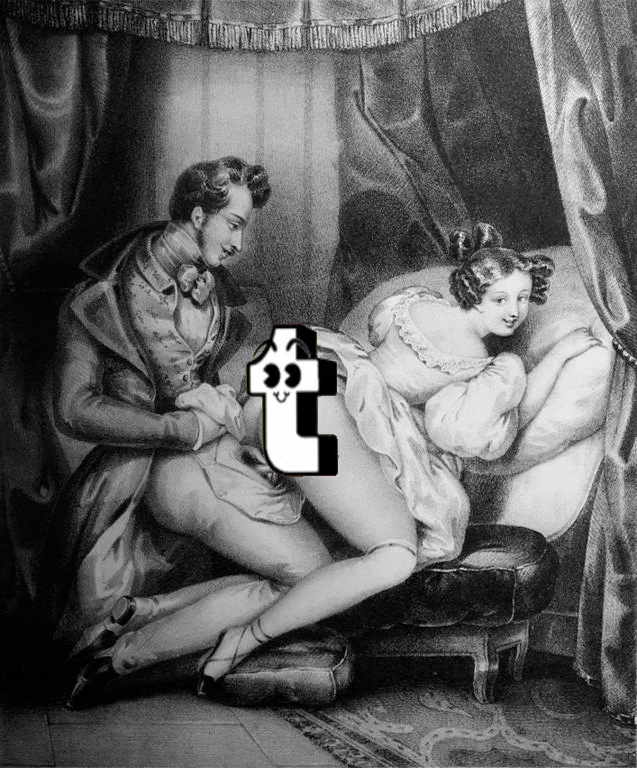
For “Porn on Tumblr is a complicated subject,” I used the GIMP to mix one of Tumblr’s own bouncing t-logo GIFs into a piece of racy Victorian porn (love their facial expressions). EZGif got the file down to a reasonable size.
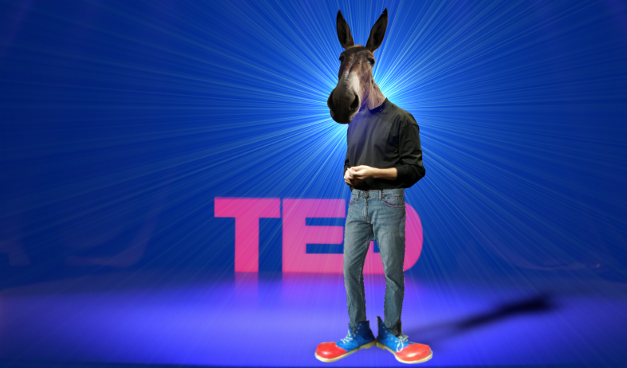
There are a lot of moving parts in the illustration for “The True Genius of Tech Leaders.” There are no images of the TED stage that are licensed CC for commercial remixing! This marked my first foray into using a machine learning image generator, with some variation on “The TED Stage” as a prompt. Ben Stanfield’s 2007 WWDC image of Steve Jobs’s torso (CC BY-SA 2.0) didn’t have legs, so I Gimped in some jean-clad legs from a public domain clip art collection. I had to fake in some of in pastel’s clown shoes (CC BY 2.0) and it wasn’t easy to cut out the head of Klearchos Kapoutsis’s donkey (CC BY 2.0). The supernova effect covered up some of my mistakes.
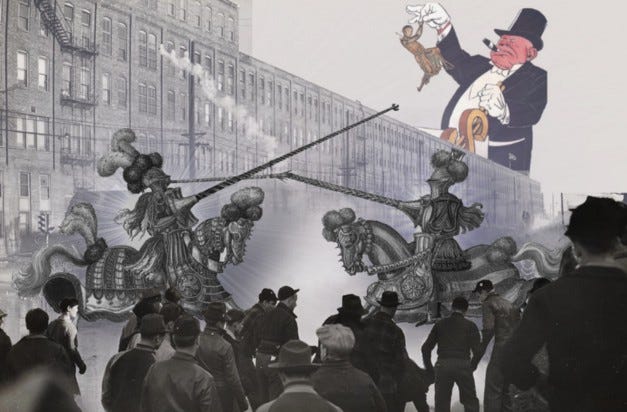
It’s an all public-domain show for “Medieval Times invents a modern union-busting tactic.” The capitalist ogre from the Soviet Capital Controls the Government illustration is back, holding aloft a medieval tapestry knight. Two more tapestry knights joust among the crowd in my close-cut-out public domain image of cops teargassing strikers.

This one, for “A giant grocery merger will send ‘inflation’ through the roof,” brings back that Rich Uncle Pennybags guy, along with Goya’s Saturn Devouring His Children. They’re in a public domain photo of a grocery aisle that had a shopping cart in the original foreground. Removing it was a huge PITA. Check out the little imperfections in the tiles. Note the supernova behind Saturn.

To illustrate “Uline’s billions fund voter suppression,” I relied on a public domain cardboard texture, a public domain line-drawing of a shredder, federally produced (thus public domain) voting icons and a ballot, adn the Uline logo (fair use).

I love the simplicity of this one: it’s Arthur “Laffer Curve” Laffer at a podium (a Gage Skidmore CC BY-SA 2.0 image) with a public domain thought-bubble containing a public domain drawing of a horse. It illustrates “Substituting economics for politics is a failure,” and references Ely Devons famously quipped, “If economists wished to study the horse, they wouldn’t go and look at horses. They’d sit in their studies and say to themselves, ‘What would I do if I were a horse?’”

To illustrate “Delegating trust is really, really, really hard (infosec edition),” I wanted to show that security was a house built on sand. I found Curt Smith’s excellent picture of a sand castle (CC BY 2.0), and set up a bunch of layers in the GIMP where I faded it into one of my beloved Matrix code waterfalls, optimizing the image later with EZGif.
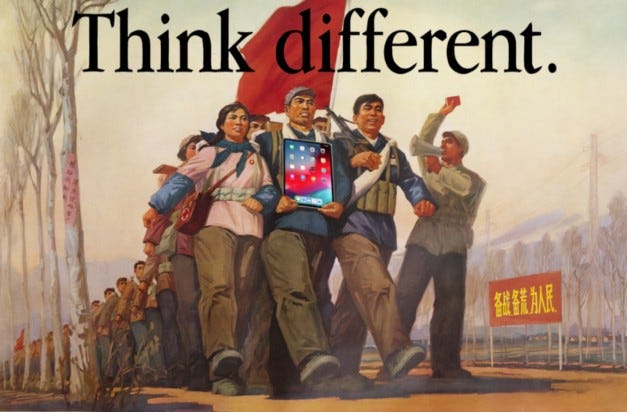
Any time I’m doing a story about Chinese authoritarianism, I start with the vast trove of public domain Chinese revolutionary poster-art, which totally capture that 19th-century subtlety-be-damned look I love. For “Apple’s business model made Chinese oppression inevitable,” I brought back the Think Different wordmark (fair use) and one of Apple’s promotional images of an Ipad (ditto).

Cryteria’s HAL 9000 made illustrating “Even if you’re paying for the product, you’re still the product.” Using an Apple privacy ad to make fun of Apple’s privacy fuckery is canonical fair use, so this one took mere seconds.
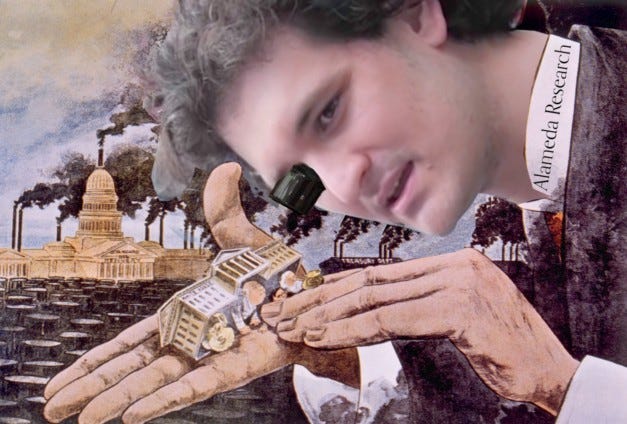
There aren’t many freely reusable images of Sam Bankman-Fried, but I was able to crop his head out Cointelegraph’s CC BY 3.0 image. Holy shit, close-cropping curly hair is a giant pain. Trustbuster heads will recognize the image: a remix of “What a Funny Little Government,” with SBF swapped in for Rockefeller. The watchmaker’s loupe came from a photo I snapped of my grandfather’s loupe, which I inherited. This one was for “Citizens United and the FTX meltdown.”

Matt Kenyon’s fantastic Financial Times illustration inspired this one, for “The Big Four accounting firms are one (more) scandal away from collapse.” Vectorportal supplied the business-suited guy image under a CC BY 4.0 license. I adjusted the arm, replaced the hand with a public domain illo of a cigarette lighter, and matted in the bomb images, fuses, burning sparks, and accountants’ eyeshades — all public domain clip art. The nuclear explosion in the background is Bikini Island, a DoD public domain work. The PWC logos are fair use.

Another one I’m indecently proud of. The starting image was J.C. Leyendecker’s Labor Day 1946 cover illustration for Hearst’s ‘American Weekly’ magazine. Most copies online are defaced with ugly watermarks, but the Internet Archive had a high-rez scan of the original. I replaced his head with a CC0 illustration of a hackneyed “hacker in a hoodie” (I keep a close-cropped version handy), and filled his sledgehammer with Matrix code-waterfall. I replaced Leyendecker’s signature with an IWW graphic depicting workers with upraised fists all joining together.

It’s hard to illustrate images where I want to use little kids. Even when I find CC licensed images of children, it feels creepy to collage them. But this CC0 image showed the kids from behind, with no faces. HAL 9000 puts in an appearance here, along with a coin-op slot blown up from a public domain image of a pinball machine, coming together to illustrate “The urinary tract infection business-model.”

To illustrate “Plato Would Ban Ad-Blockers,” I started with a CC0 image of a statue of Plato with a Greek temple behind him. A lot of careful cutouts gave him HAL9000 eyes, and replaced part of the temple with a Matrix code waterfall. The background is a montage of terrible web-ads whose colors have been inverted and partially desaturated.
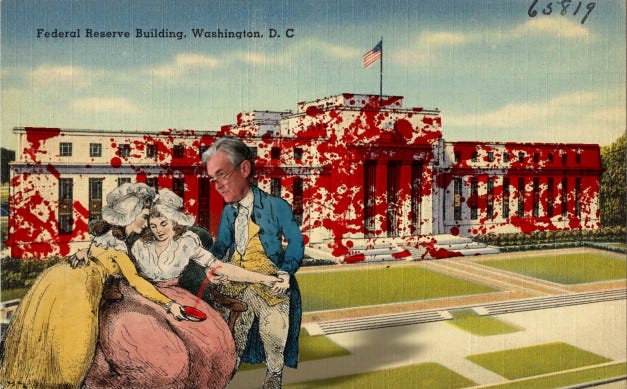
The pic for “This ‘inflation’ is different” is another banger, if I do say so myself. Start with a vintage, public domain postcard of the federal reserve, splash liberally with Mosaic36’s CC BY 2.0 blood spatter. In the foreground, a closely cropped woodcut of a doctor performing a bloodletting, the blood hand-tinted, with a public domain headshot of Federal Reserve Chairman Jerome Powell replacing the doctor’s head. I was really happy with the cutout job on his glasses.
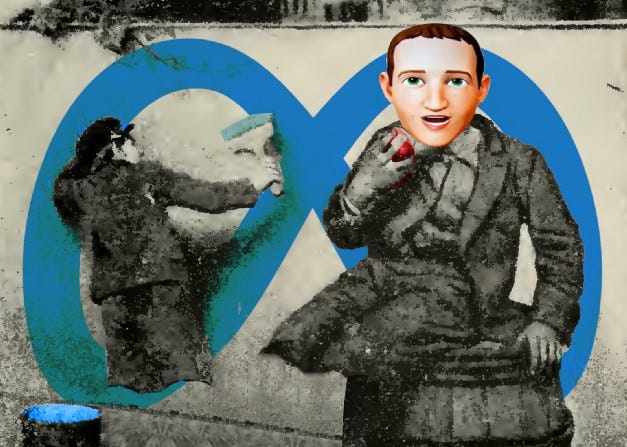
With “‘Metaverse’ means ‘pivot to video,’” I knew I needed to start with an illustration from a public domain edition of Twain’s Adventures of Tom Sawyer showing Tom tricking another kid into white-washing Aunt Polly’s fence. The Internet Archive yielded a wide selection of these, with the best being the first edition, in which the fence has become a wall. I did so much cut and paste and blend to erase everyone’s legs and get the Meta logo onto the wall. Zuck’s Metaverse avatar’s head is fair use.
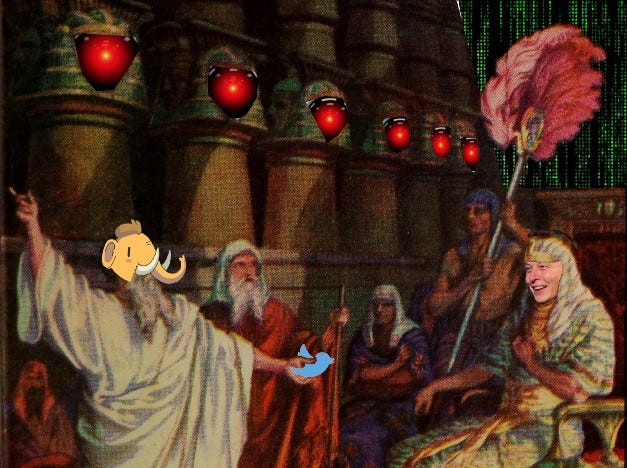
The illo for “Better failure for social media” also plays all the hits: Cryteria’s HAL 9000, a Matrix code waterfall. Tusky, the Mastodon mascot, and the Twitter logo, make it clear that Moses is petitioning the muskfaced Pharoah for interoperability. Every pic of Musk makes him look like an asshole, but Heisenberg Media’s photo of him at 2013’s The Summit (CC BY 2.0) is an exceptional example of the form. This was another one where I found the public domain illustration I wanted covered in Alamy watermarks, figured out which book they’d ganked it from, and located a high-rez scan on the Internet Archive to get a clean copy from.
Cory Doctorow (craphound.com) is a science fiction author, activist, and blogger. He has a podcast, a newsletter, a Twitter feed, a Mastodon feed, and a Tumblr feed. He was born in Canada, became a British citizen and now lives in Burbank, California. His latest nonfiction book is Chokepoint Capitalism (with Rebecca Giblin), a book about artistic labor market and excessive buyer power. His latest novel for adults is Attack Surface. His latest short story collection is Radicalized. His latest picture book is Poesy the Monster Slayer. His latest YA novel is Pirate Cinema. His latest graphic novel is In Real Life. His forthcoming books include Red Team Blues, a noir thriller about cryptocurrency, corruption and money-laundering (Tor, 2023); and The Lost Cause, a utopian post-GND novel about truth and reconciliation with white nationalist militias (Tor, 2023).
